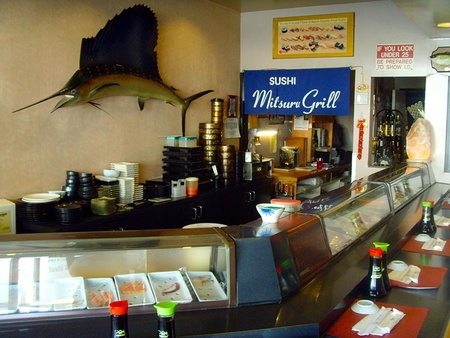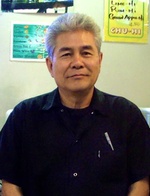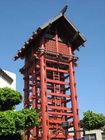Mitsuru Sushi & Grill is a cozy restaurant located by 1st Street and San Pedro of Little Tokyo. Its atmosphere projects an air of unassuming invitation. The main store window displays an amazing and colorful array of plastic sushi pieces, organized in the manner in which they may be ordered and prepared. In the very front of the restaurant is a simple sushi bar where one has complete visual access to witness the traditional manner of making sushi. The restaurant then deepens into a larger eating area containing a lengthy lunch counter and flanking booths. It would be an understatement to say that Japanese food and restaurants have accrued incredible popularity within the last few decades.
At first glance Mitsuru Grill might appear just as any “ethnic” restaurant, responding to the current trends of the communal palette. However, a closer look at the pictures on the walls warrants a different prospective. Behind the lunch counter, and above each booth, hang pictures of historic Little Tokyo. Some of the pictures are in color, but the vast majority are black and white shots from around the middle of the 20th century. One of these pictures displays 1st Street in the midst of what seems like a parade. In this photograph, beneath an enormous banner, a small white awning of a pharmacy can be seen. This pharmacy is Misturu Grill, and the photograph accurately places the restaurant in the contextual history of Little Tokyo.
The head chef and owner of Misturu Grill, Mamoru Hanamura, is an Issei, or a first generation immigrant from Japan. Mr. Hanamura, in his mid fifties, has managed the restaurant for the last thirty-five years and has witnessed the tremendous changes that Little Tokyo has experienced from behind his store front windows. He recounts, that he and his elder sister opened the store together when he was twenty-six years old. In its earliest days Mitsuru Grill was a simple lunch counter located inside a pharmacy. When his sister decided that she no longer wanted to operate the counter, Mr. Hanamura took over the duties himself.
Mr. Hanamura explains that he comes from a long family tradition of cooks and food preparation and so this was an invaluable opportunity to continue cooking his native food in a foreign land. But, however foreign America may have been to Mr. Hanamura at the time, Little Tokyo at least had a breath of familiarity. He explains that in the earlier days, Little Tokyo was much more “Japanese” then it is today. The area was much more residential and the vast majority of the business owners and residents were either Japanese immigrants or their first generation Japanese-American offspring. He remarks, there used to be immigrants in Little Tokyo who lived out their entire lives not speaking a word of English. This is almost impossible to imagine presently, unless perhaps those immigrants now spoke Spanish. Little Tokyo has experienced a massive cultural Diaspora. Although the neighborhood itself has expanded, the number of residents and especially Japanese residents has decreased dramatically. The majority of Mr. Hanamura’s staff members are Latinos and his clientele is no longer specifically Japanese. This is made particularly evident by his menu, which promotes an abundance Japanese-American fusion dishes.

This photograph shows a typical lunch of ramen and assorted sushi that one could enjoy at Mitsuru Grill.
Mr. Hanamura explains that thirty years ago, the climate of little Tokyo was much different. Now, Little Tokyo is more like a business center mixed with a historical and cultural attractions. But before, Little Tokyo was a vibrant and living community. There were hotels everywhere and tour buses every weekend flooded the streets of Little Tokyo with tourists. Just before the 1970s there were multiple annual festivals (called matsuri) that drew massive crowds to the Little Tokyo neighborhood. This consistent flow of business provided Mr. Hanamura with the opportunity to expand the counter into a full fledged restaurant and thus Mitsuru Grill came into existence.
Mr. Hanamura remarks, that in the past all the business owners knew and supported each other. Mr. Hanamura would buy all of his supplies from local grocers. Then these local grocers would come and eat meals at his establishment. He laments the loss of community, saying that “before if I had a problem or an issue, any one of my customers would come in and sit down to have lunch with me and talk about it. The customers were more like friends and family.” Presently however, although business has not suffered, there is definitely a separation between Mr. Hanamura and his clientele.
When asked about what he thinks caused the community to dissipate, his answer is fast and definitive: money. When he first opened his shop, the dollar was worth around three times the amount of the yen. Japanese immigrants when they first arrived here had little money and residential restrictions, so they settled into a specific community and made a place for themselves in Los Angeles. However, after the implementation of civil rights policies aimed at Japanese-Americans and the rise of Japanese economic power, immigrants felt less of a need or desire to be all in one community. With more money, they could move to more desirable locations and slowly the community of Little Tokyo faded into history.
But Hanamura has an over all positive outlook on the changes that little Tokyo has undergone and praises the now present diversity of the community. He believes that Little Tokyo might not be the most accurate name in terms of describing the neighborhood, but he enjoys seeing Koreans, Chinese, Japanese, Mexicans and Americans all enjoying his food and the history of the Little Tokyo. He still gets great business from the crowds matsuri draw, and has an enormous, if widespread, second generation Japanese-American clientele. Every New Year he and his staff stay up all night making elaborate sushi platters that customers faithfully order annually. He has even begun to teach his two daughters how to cook traditional Japanese cuisine and some of his fusion dishes as well. Although the community has shifted a lot through the years, Mamoru Hanamura and Mitsuru Grill have kept in touch with the ever changing culture while maintaining tradition and providing a valuable and irreplaceable chronological landmark.
* Discover Nikkei partnered with Professor Morgan Pitelka of Occidental College and his students taking the Spring 2010 seminar “Japanophilia: Orientalism, Nationalism, Transnationalism” on a meaningful community-based documentation project. The students interviewed owners of five long-time Little Tokyo businesses to create Nikkei Albums and articles.
View the Nikkei Album collection: Mitsuru Grill
© 2010 Jonathan Gartrelle






